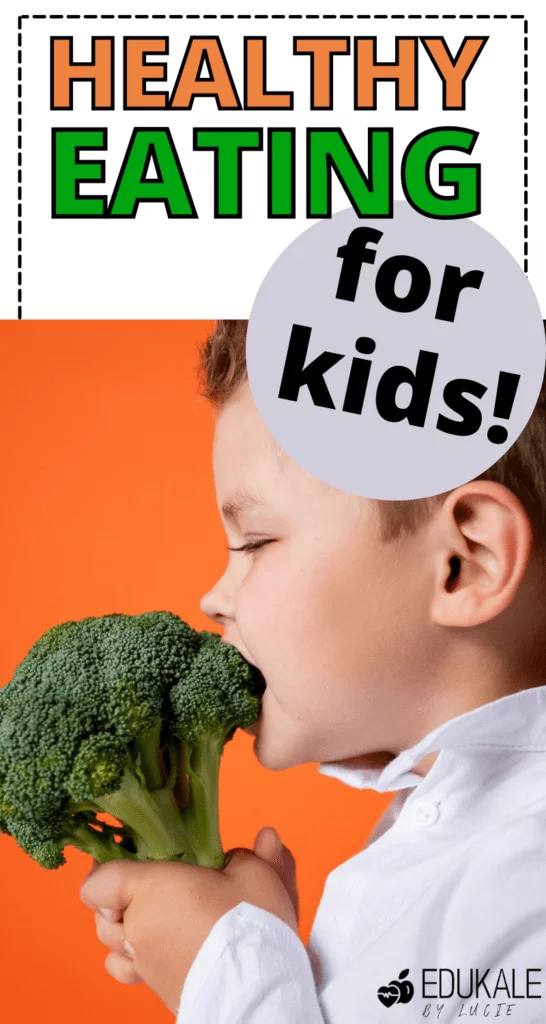This post contains affiliate links from which I may receive a small commission, at no extra cost to you. In no way does this affect my opinion or the information I provide on the product. Please read my disclaimer for more info.
Healthy eating can be hard— and it can be even harder when it comes to your kids.
You may feel like you know the basics of creating healthy and balanced meals, but then your child is super picky.
You may have a child who mindlessly eats what you put in front of them, but you want them to get some food education.
You could also be looking to improve your eating habits for the benefit of your entire family.
Whatever the reason, I’m here to help.
Before I get into the tips, I do want to point out that I am not specialized in child nutrition, and that you should go to one of these professionals if you are really struggling. My goal here is just to give basic nutrition tips for families! Also, I am not a parent myself so obviously these are just theories— feel free to let me know what works for your kids!

How to eat a healthy and balanced diet— kid edition!
When it comes to the actual foods to give your kids for a healthy and balanced meal, it’s pretty identical to what you would want for yourself. Healthy eating means giving them a wide variety of foods with all the nutrients they need to thrive. It’s about eating balanced and varied meals that you all enjoy, helping them fuel their body the right way, keeping them feeling happy and energized, and encouraging them to build a healthy relationship with food.
In general, eating mainly whole foods and limiting processed foods is the goal for healthy eating. Of course, this doesn’t mean that you can never give your kids junk food or sweets, but it should be the exception rather than the norm.
It’s really important not to classify foods as “good foods that you should ALWAYS be eating” and “bad foods that you should NEVER have”. There’s room for any kind of food in your children’s diet, it’s just all about balance.
With that being said, some foods are undeniably healthier or more nutrient-dense than other foods. These are the foods that your kids should be having most of the time. They mainly include whole, minimally processed foods such as:
- Vegetables
- Fruit
- Whole grains such as brown rice, whole-wheat pasta, oatmeal, buckwheat, bulgur, quinoa…
- Beans and legumes such as lentils, black beans, kidney beans, chickpeas…
- Nuts and seeds

Now here are the foods that you shouldn’t be eating on a regular basis, but that can have a spot on your plate once in a while. They mainly include super processed foods that have few nutrients and tons of calories.
- Refined carbohydrates, such as cake, cookies, candy, and—to a lesser extent— products made with white flour.
- Trans fats (artificial trans fat have been banned) but still found in fast food (read about the effect of fast food here!), snack foods, ready-to-eat meals…
- Processed meat, such as salami, bacon, sausages, ham…
It’s also important to make sure that your kids are getting enough calcium. I don’t personally think that dairy is the best option for this, but if you feel like it’s too difficult for your child to get enough calcium from other sources, dairy is ok.
Here are some other sources of calcium: beans and lentils, cooked leafy greens such as spinach and kale, almonds, seeds such as sesame seeds and chia seeds, calcium-fortified foods such as cereal or plant-based milk, edamame and tofu…
Don’t hesitate to check out my article on healthy eating for beginners which has some other helpful tips!
How to give your kids healthy eating habits.
Although the food on your kid’s plate is very important, healthy eating doesn’t stop there. It’s also important to give your child good eating habits as well.
The best way to do this is to lead by example. If you eat well yourself, your kids will follow your lead.
The number one thing I would encourage is having family meals with no electronic distractions. Take mealtime as an opportunity to get together as a family and have meaningful conversations.

You’re in charge of what the meals look like, and you shouldn’t cater to everyone’s specific taste. However, it may be a good idea to offer a few different food items so that each child can have one food that appeals to them.
Start by serving small portions to your kids, and don’t pressure them to eat anything. Let them explore what they have in their plate while having conversations about their day, for instance. The less you obsess over what they are eating, the more comfortable they will be with it.
I also recommend having a meal and snack schedule so that your child knows what to expect. Have healthy and balanced snack or meal options available for them every 3 hours or so. Let them know that this is their chance to give their body energy if they want to. If they don’t want to, they will have another option to do so in 3 hours (or however many you choose for your schedule).
How to make sure your kids have a healthy relationship with food.
I don’t like talking about calories for kids, unless they are in a situation where they are overweight or underweight and it has been recommended by a doctor, of course. Other than that, kids are generally better than us at knowing how much they need to eat. It’s important to encourage your kids to listen to their hunger and fullness cues.
Don’t force them to eat if they aren’t hungry, and let them get a second helping if they want to. However, as the parent, you get to decide what food is being served. If they want second helpings of dessert but don’t want anything to do with the vegetables, or if they are “never hungry” for dinner but “always hungry” for cookies at snacktime, you should intervene.
For instance, if they want cookies but dinner is only one hour away, you can say something like “We’re going to be eating a yummy dinner very soon, and if you still want to, you can have a cookie then.”
You could also talk about your own feelings at meal time and say things like “This is delicious, but I’m not hungry anymore so I’m going to save it for later”.
This is a great way to initiate your kids to mindful and intuitive eating.
It’s also important not to talk about food, calories, or weight gain in a negative way in front of your child. If you say things like “this cookie is bad” or talk about how food can make you fat, it may trigger some unhealthy eating behaviors in your kids.

I encourage not putting any type of food on a pedestal, and not bashing any type of food either. You can serve a few sweets or “junk food” items alongside the veggies and brown rice if your child asks for them, without drawing any particular attention to them. Let your child know that after they have finished these foods, they won’t have any more.
You should also try not to praise your child for eating or not eating certain foods. You shouldn’t bribe them with dessert if they finish their vegetables, for instance. PS: here’s an article I wrote about healthy eating if you hate vegetables!
Finally, you shouldn’t discuss weight with a child. If a doctor has advised for your child to gain or lose weight for health reasons, focus on the health aspect with them. Make sure that you are providing them with healthy and balanced meal options from mainly whole foods.
You can absolutely let them have sweets or junk food on occasion, without making it a big deal. You really don’t want to trigger restrictive eating patterns and an unhealthy relationship with food for them.
How to educate your kids around food.
I encourage telling kids about the benefits of food in an age-appropriate manner when an opportunity arises.
For example, you can tell a small child that eating carrots will help their eyes be super strong, or that eating berries will help their bodies fight off sickness. You can tell an older child that carrots have vitamin A, which is important for healthy eyes, or that berries have antioxidants, which strengthens your immune system.
It’s important to let them know that food is a fun and delicious way to give their bodies all of the things they need to be healthy and happy. You can also say things like “Cookies give you energy, and energy is good. But if you eat too many cookies, you won’t have room for all of the other foods that give your body other powers like healing from cuts, fighting sickness, growing strong bones…What do you think about that?”
It’s also a good idea to involve your kids in grocery shopping and preparing meals in age-appropriate ways. This can be a great way to expose them to different foods and teach them certain things.

What if my child is a picky eater?
For a very picky child, I would follow all of the above recommendations, meaning enjoying healthy and balanced family meals, offering a variety of foods, setting a meal and snack schedule (but letting them decide how much to eat within these timeframes), educating them about foods when appropriate, etc.
I would also try to have some of the safe foods they like at every meal, but in small portions. For instance, if your child only eats chicken nuggets, try to serve one alongside some veggies and pasta. If they ask for more, say something like “There are no more chicken nuggets right now. You can have some next time. Instead, would you like to try the broccoli?”
You don’t want to pressure your children into eating the healthier foods. Instead, offer them consistently without drawing too much attention to them and be a good role model by enjoying these foods in front of your kids.
Healthy eating for kids in conclusion.
Healthy eating for kids means giving them a wide variety of foods with all the nutrients they need to thrive. It also means building healthy eating habits by enjoying family meals, encouraging them to participate in food preparation, educating them about nutrition in age-appropriate ways, and making sure they develop a healthy relationship with food.
-Lucie
If you’re interested in nutrition, its impact on our health, and the science behind it, you should definitely read How Not to Die. In this book, Doctor Michael Greger, founder of Nutrition Facts, examines the top causes of death in America and explains how your diet can prevent— and in some cases even reverse— them. His advice is all backed by science and he writes in a very clear and entertaining way. This book isn’t a list of what you already know. It will teach you the keys to living a long healthy life, in a simple and practical way, and without spending fortunes on supplements and pills!
PLUS if you want to take it a step further, you can check out the How Not to Die Cookbook to implement the advice easily!



Comments are closed.